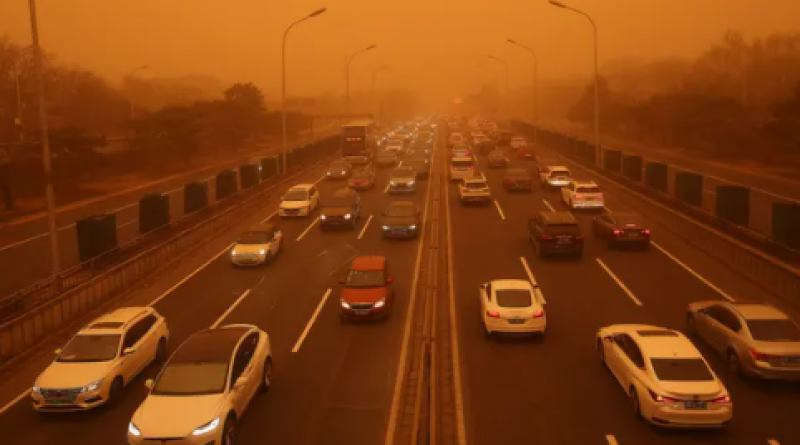China sandstorms highlight threat of climate crisis.

Experts say extreme weather including droughts will become more common as planet heats.
Recent sandstorms that shrouded Beijing in a post-apocalyptic orange haze and intensive droughts in other parts of the country are bringing into stark relief the challenges China faces from rising temperatures induced by the climate crisis.
The widespread sandstorms that pelted the capital and spread as far as central China for several days in mid-March and again at the end of the month were brought on by lower than average snow cover and precipitation, as well as higher than normal temperatures and winds across Mongolia and northern China.
The combination provides perfect conditions for creating sandstorms and could signal more frequent dusty weather as temperatures climb in the region.
“Although the sandstorms were mainly caused by natural factors, they remind us there is only one Earth for mankind,” Liu Youbin, a spokesman for the environment ministry, told a press conference in Beijing.
“We must give great importance to ecological protection and construction and strengthen international cooperation,” he said.
Since 1978 China has been trying to combat encroaching sands from the Gobi Desert region by planting a series of forest strips through its northern areas. This “Great Green Wall” has been somewhat effective at reducing erosion and slowing desert expansion, but does little to knock down high-altitude dust blown in from afar.
“Hotter summers and shorter winters with less snowfall will likely lead to general declines in moisture levels of the soil [across the region], making it more prone to being scoured by winds and carried far away, and threatening China’s laudable tree-planting efforts,” said Darrin Magee, a professor of environmental studies at Hobart and William Smith Colleges in the US and an expert on China’s water resources.
“Climate change will almost certainly exacerbate the sandstorm issue for north-east China,” he said.
While the sandstorms are a natural occurrence, there are a number of human factors at play that contribute to the intensity besides the climate crisis.
“In the places where the sand is originating from, both recent overgrazing and desertification have contributed to the desertification of the grasslands of Mongolia,” said Liu Junyan, a Beijing-based climate and energy campaigner for Greenpeace East Asia.
“I think one of the most important things is to stop overgrazing, and this is something the Chinese government has done in the past two decades in parts of northern China,” she said.
On Tuesday, China’s State Council released new guidelines for strengthening grassland protection, aiming for a 57% rate of stable vegetation coverage in its grasslands by 2025 as well as further efforts to deal with overgrazing or illegal grazing on protected grasslands.
For Magee, the impact of grazing from semi-nomadic herders in Inner Mongolia and Tibetan areas is more overblown than other industrial factors that lead to depleted groundwater and drying in the region.
“A few thousand herders practising what herders have done for centuries are clearly not the problem,” he said. “Continued high rates of groundwater extraction for mining, industry and agriculture in northern China don’t help, either, and unfortunately I find it increasingly difficult to believe that climate change buffers, green belts or inter-basin water transfers will really have an impact.”
Major water transfer projects such as the South-to-North series of canals and pipelines are mainly for supplying water to heavily populated cities such as Beijing or increasingly industrialised agriculture zones near those cities, and do little to restore depleted groundwater.
Besides the sandstorms, parts of China have recently been hit by severe drought, including the eastern coastal provinces of Zhejiang and Fujian, which were mainly dry from October last year through February, with some respite in March.
Further south, China’s economic powerhouse of Guangdong province and the largely rural province of Guangxi have also suffered under drought conditions since late last year, with authorities here increasingly resorting to cloud seeding to induce rainfall.
The province where conditions are now the most severe is Yunnan, in the country’s far south-west, where 82% of the province is experiencing drought, leading to water shortages for people and livestock in the worst areas.
Liu Junyan hopes that the twice-postponed UN biodiversity conference known as Cop15, scheduled to be held in Kunming, Yunnan, in mid-October, can highlight the interactions between climate change, water resources and biodiversity.
According to studies of temperature increases across China, Yunnan is the province with the most climate-related warming over the past decade and has been affected by frequent droughts in recent years.
“I was recently in Yunnan to check out the weather, and it’s even more horrible than in previous years,” Liu said. “On the whole, the government still doesn’t consider that climate change has a big, big impact on biodiversity.”
3 April 2021
The Guardian




